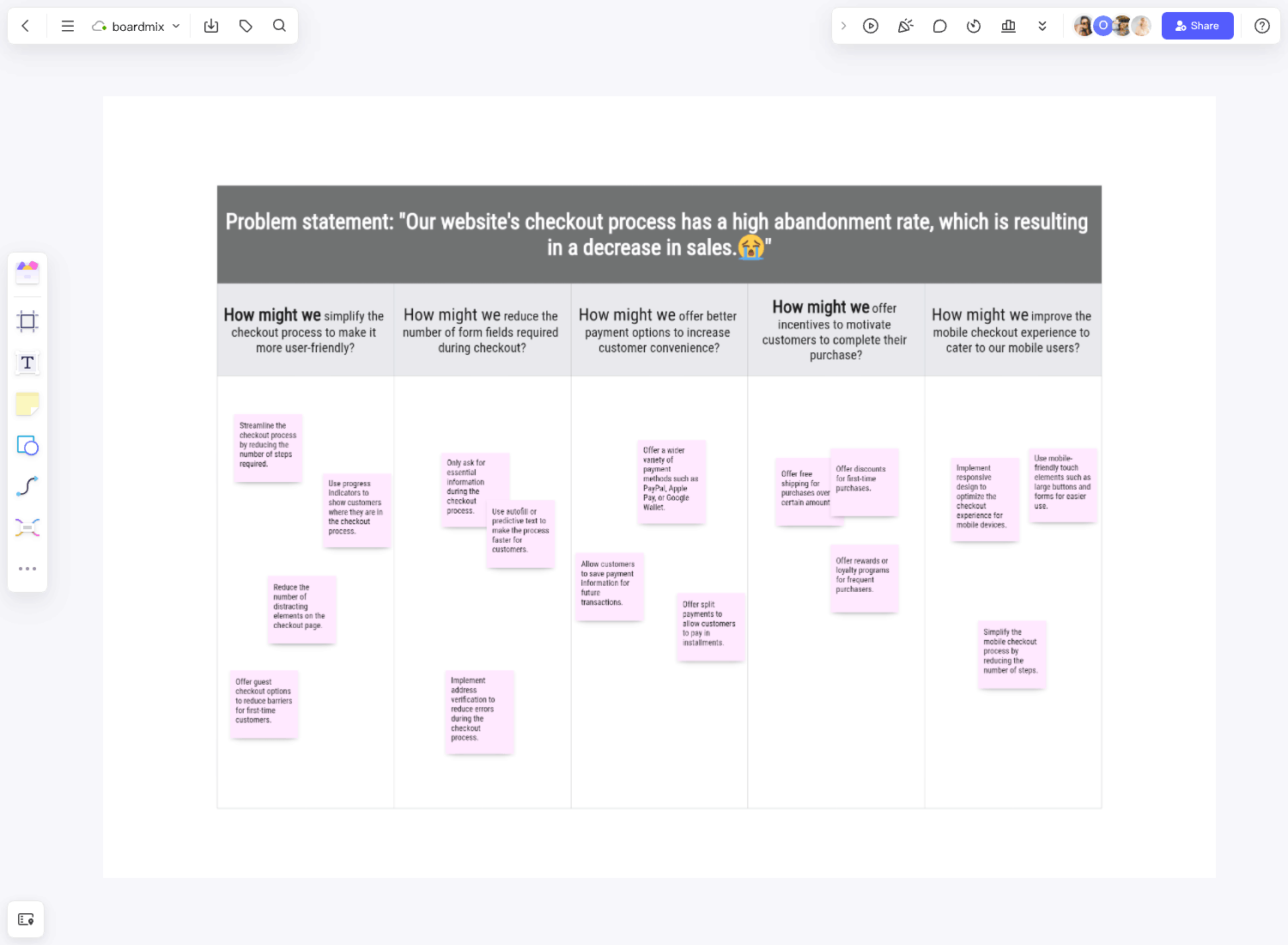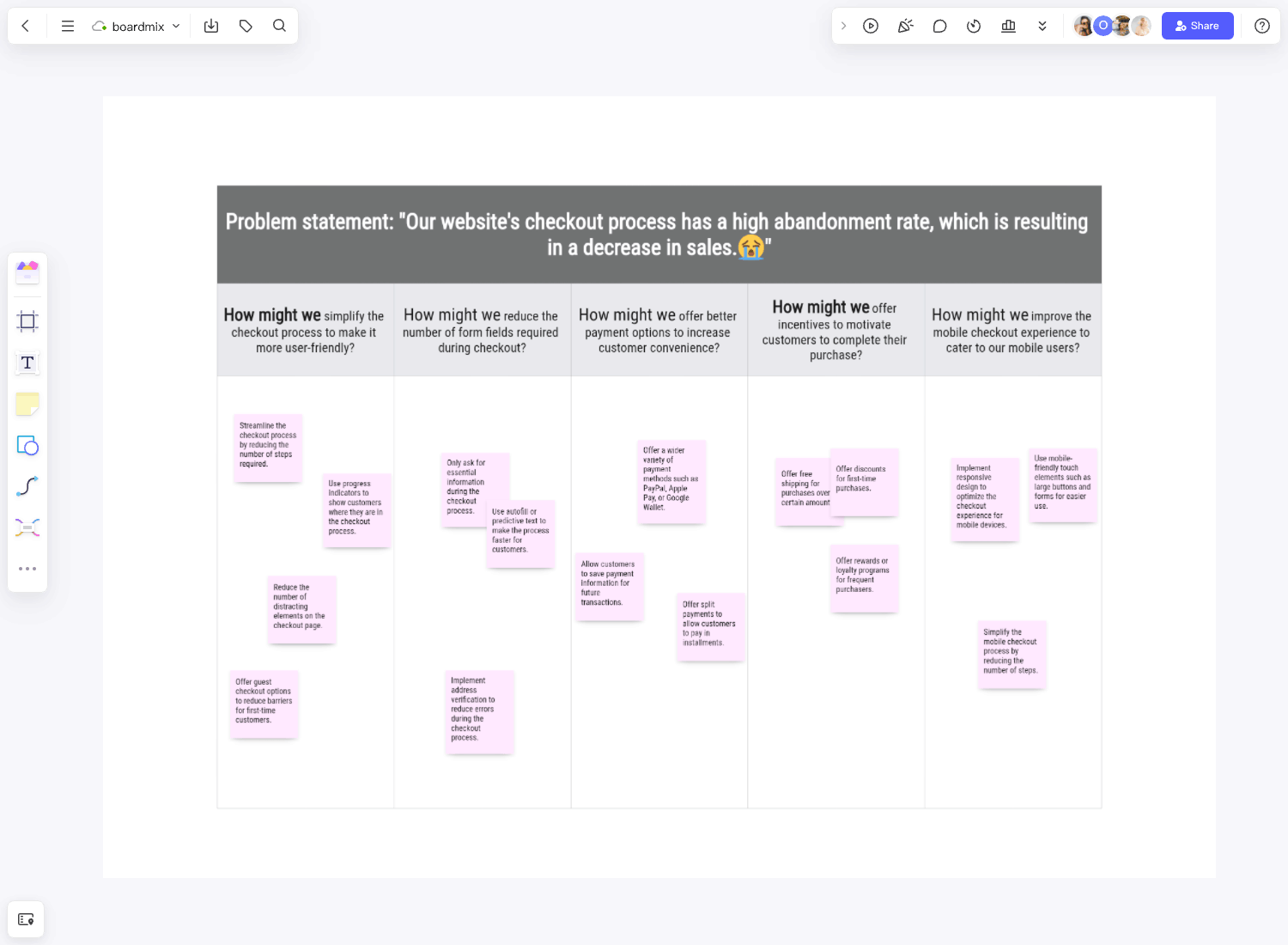Brainstorming can be overwhelming. As much as your team wants to flesh out new ideas for specific projects, starting it can be a handful. Companies and organizations use the How Might We template to push innovative concepts and ideas from their employees. Instead of pushing members to find answers on the spot, the template lets you encourage each one to contribute related ideas to the topic at hand.
What are how might we (HMW) statements?

In a how might we template, you’ll see 3 questions a team must address, as shown below. It’s a technique that helps people brainstorm ideas. The template’s popularity continues to increase, especially for leaders in the corporate world. It’s a straightforward template and can simplify major issues and transform them into opportunities through specific and creative solutions.
- How: While you might not have the answer yet, this question on your how might we template will open opportunities for creative concepts that can eventually solve issues without increasing risk factors.
- This section emphasizes the possibilities of various ideas leading to a solution. It allows all team members to contribute without judgment, which means all inputs are welcome.
- The final question on the how might we template ensures that regardless of the issue, teams can solve it with teamwork and collaboration.
Benefits of using a How Might We (HMW) template
The following are the specific advantages you’ll experience when using the how might we template.
- It helps generate fresh ideas. Once the team is stuck in problem-solving, coming up with how we might statements will be helpful to flesh out new ideas. Since you’ll have different angles to approaching specific problems, you can develop creative solutions your team might not have thought of.
- It encourages better collaboration. The how might we approach is not executed by one person only. You can work with other team members on your possible initiatives for the issue. As a result, you can create innovative solutions.
- It allows you to think outside the box. Since you’re considering everyone’s inputs using the how might we template, you’re allowing ideas to flow from different perspectives. Along the way, you can gather unusual solutions that can be used to solve the issues.
How Might We (HMW) Templates
The Challenge-Focused 'How Might We'
This 'How Might We' template is used to tackle challenges head-on by fostering creativity and solution-oriented thinking.
Challenge Identification
First, define the challenge or problem you're facing. It could be personal, such as "How might I improve my time management?" or work-related, like "How might we increase our client base?"
Possible Solutions
Then, brainstorm and list all potential solutions to the problem, no matter how big or small. The aim is to stimulate creative thinking and explore all possible avenues.
Implementation Steps
Finally, choose the most viable solution from your list and draft a concrete plan on how to implement it. This plan should include actionable steps, resources needed, and a timeline.
The Growth-Oriented 'How Might We'
This template is used to encourage personal and professional growth by highlighting areas of improvement and potential growth opportunities.
Growth Area Identification
Identify an area where you'd like to grow or improve. It might be something like "How might we expand our market presence?" or "How might I improve my public speaking skills?"
Brainstorming Potential Approaches
Create a list of potential methods, strategies, or practices that could help you achieve your growth goal. Try to be as innovative and expansive as possible in your thinking.
Actionable Steps Towards Growth
From your list, select the best approach(es) and draft a roadmap outlining specific steps towards achieving your growth goal.
The Innovation-Driven How Might We
This template encourages innovative thinking and the exploration of new ideas, methods, or products.
Innovation Objective
Start by outlining the innovation objective, such as "How might we streamline our communication processes?" or "How might I incorporate more exercise into my daily routine?"
Brainstorming Innovative Ideas
Then, brainstorm a variety of novel ideas or approaches that could help achieve the innovation objective. Remember, the aim is to push boundaries and think outside the box.
Innovation Implementation Plan
Finally, choose the most feasible innovative idea from your brainstorming session and outline a step-by-step implementation plan.
How to Use a 'How Might We' Template
'How Might We' (HMW) questions are a cornerstone of design thinking. They are designed to provoke thoughtful, open-ended ideation by framing problems as opportunities for innovation. Using an HMW template can help you craft meaningful questions that spark creativity and drive solution-focused thinking. Below is a step-by-step guide on how to effectively use a 'How Might We' template:
Step 1: Identify Your Challenge
The first step is to identify the problem or challenge you're facing. This could be anything from improving customer satisfaction to enhancing productivity in the workplace. Write down your challenge in the form of a statement.
Step 2: Transform Your Challenge into a HMW Question
Now, reframe your problem statement into a 'How Might We' question. The beauty of HMW questions is their inherent optimism—they imply that a solution is possible. They should be broad enough for a wide range of solutions but narrow enough to focus on your team's ideation. For example, the problem statement "Our website isn't user-friendly" could be reframed as "How might we make our website more user-friendly?"
Step 3: Brainstorm
Once you have your HMW question, start brainstorming potential solutions. Encourage all participants to share their ideas, no matter how out-of-the-box they might seem. Remember, this is a judgment-free zone—the goal is to generate as many ideas as possible. Record all ideas for further exploration and evaluation.
Step 4: Select Promising Ideas
After the brainstorming session, go through the list of ideas and identify those that are promising and worthy of further exploration. Consider factors such as feasibility, impact, and alignment with your goals or objectives.
Step 5: Prototype and Test
Choose one or more of the promising ideas to prototype. This will help you understand how the solution works in a real-world scenario. After prototyping, test the solution with end users and gather their feedback.
Step 6: Refine and Implement
Based on user feedback, refine your solution until it effectively addresses your initial HMW question. Then plan for its implementation, including any necessary steps like securing resources, setting timelines, assigning tasks, etc.
Remember, 'How Might We' is not just a tool to start your ideation process; it's also a mindset that encourages looking at problems as opportunities for improvement and innovation. By consistently using the 'How Might We' template in your daily work, you foster a culture of creativity and continuous learning.
How to run a how might we (HMW) process in Boardmix?
The How Might We template is a straightforward framework you can use among your team quickly.
1. You can do it traditionally with a marker and a whiteboard. Another means would be using a digital whiteboard like Boardmix.

2. Add a problem statement to the template. You can use the keywords user, user requirement, and insight.

3. Allot some time for members to formulate their how might we questions. Sticky notes will be useful in this process.
4. Brainstorm the questions and narrow them down to those you decide to move forward with. You can vote on the questions that might be used.
FAQs about how might we
How does the how might we statement impact the ideation stage?
Using the how might we template opens up the team’s ideation sessions, allowing you to explore concepts and ideas to help you solve a problem within the company.
What is the difference between POV and HMW?
A POV or point-of-view refers to a brief description of the issue or need that the team or company must solve. Meanwhile, the How Might We template contains short questions that start the process of generating solutions and ideas. As you can see, the POV is relatively part of the how might we creation process.







